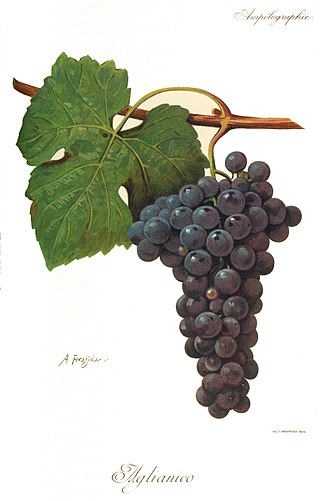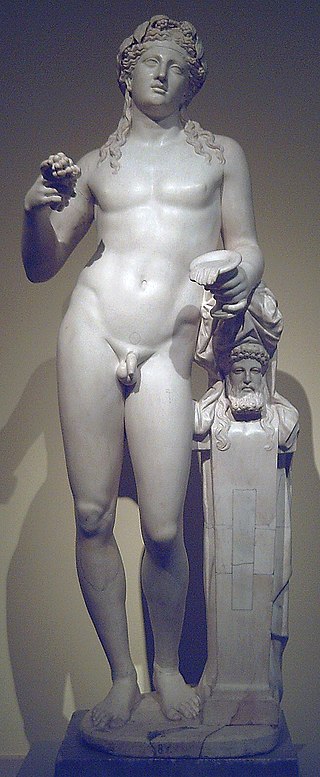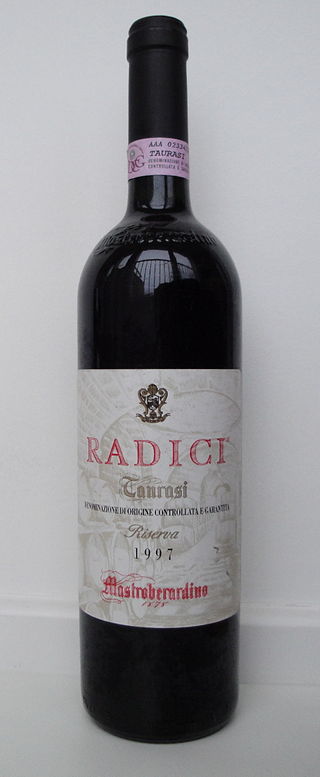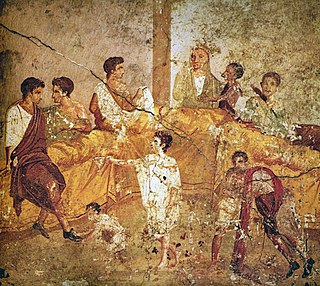
Wine is an alcoholic drink made from fermented fruit. Yeast consumes the sugar in the fruit and converts it to ethanol and carbon dioxide, releasing heat in the process. Wine is most often made from grapes, and the term "wine" generally refers to grape wine when used without any qualification. Even so, wine can be made from a variety of fruit crops, including plum, cherry, pomegranate, blueberry, currant and elderberry.

Mead, also called hydromel, is an alcoholic beverage made by fermenting honey mixed with water, and sometimes with added ingredients such as fruits, spices, grains, or hops. The alcoholic content ranges from about 3.5% ABV to more than 20%. The defining characteristic of mead is that the majority of the beverage's fermentable sugar is derived from honey. It may be still, carbonated, or naturally sparkling; dry, semi-sweet, or sweet.

Viticulture, viniculture, or winegrowing is the cultivation and harvesting of grapes. It is a branch of the science of horticulture. While the native territory of Vitis vinifera, the common grape vine, ranges from Western Europe to the Persian shores of the Caspian Sea, the vine has demonstrated high levels of adaptability to new environments, hence viticulture can be found on every continent except Antarctica.

Aglianico is a black grape grown in the southern regions of Italy, mostly Basilicata and Campania. It is considered with Sangiovese and Nebbiolo to be one of the three greatest Italian varieties. Aglianico is sometimes called "The Barolo of the South" due to its ability to produce highly refined, complex fine wines like the famous wine from Piedmont, Barolo.

Italian wine is produced in every region of Italy. Italy is the world's largest wine producer, as well as the country with the widest variety of indigenous grapevine in the world, with an area of 702,000 hectares under vineyard cultivation, and contributing a 2013–2017 annual average of 48.3 million hl of wine. In 2018 Italy accounted for 19 per cent of global production, ahead of France and Spain. Italian wine is both exported around the world and popular domestically among Italians, who consume an average of 42 litres per capita, ranking fifth in world wine consumption.
Ancient Greek cuisine was characterized by its frugality for most, reflecting agricultural hardship, but a great diversity of ingredients was known, and wealthy Greeks were known to celebrate with elaborate meals and feasts.
Caecuban wine came from a small territory, ager Caecubus, at Amyclae in coastal Latium. Around 70 BC, Varro already regarded this district as a place of legendary wealth. Strabo described the area's reputation for wine in his Geography: "The Caecuban Plain borders on the Gulf of Caieta; and next to the plain comes Fundi, situated on the Appian Way. All these places produce exceedingly good wine; indeed, the Caecuban and the Fundanian and the Setinian belong to the class of wines that are widely famed, as is the case with the Falernian, the Alban and the Statanian."
A fumarium was a smoke chamber used in ancient Rome to enhance the flavor of wine through artificially "aging" the wine. Amphorae were placed in the chamber, which was built on top of a heated hearth, in order to impart a smoky flavor in the wine that also seemed to sharpen the acidity. The wine would sometimes come out of the fumarium with a paler color. In his book Vintage: The Story of Wine, Hugh Johnson noted that Pliny the Elder and Columella did not recommend that "first-growth wines" like Falernian, Caecuban, and Alban be smoked.

The oldest evidence of ancient wine production has been found in Georgia from c. 6000 BC , Iran from c. 5000 BC, Greece from c. 4500 BC, Armenia from c. 4100 BC, and Sicily from c. 4000 BC. The earliest evidence of fermented alcoholic beverage of rice, honey and fruit, sometimes compared to wine, is claimed in China.

Straw wine, or raisin wine, is a wine made from grapes that have been dried off the vine to concentrate their juice. Under the classic method, after a careful hand harvest, selected bunches of ripe grapes will be laid out on mats in full sun.. This drying will probably be done on well exposed terraces somewhere near the wine press and the drying process will take around a week or longer. Small scale productions were laid out on flat roofs; however, if this still happens, it is extremely rare nowadays.
Greco is an Italian wine grape that may be of Greek origin. The name relates to both white and black grape varieties. While there is more land area dedicated to Greco nero, the Greco bianco is the grape most commonly referred to by "Greco". In the Campania region it is used to produce the denominazione di origine controllata e garantita (DOCG) wine Greco di Tufo. In Calabria, it is used to make the denominazione di origine controllata (DOC) wine Greco di Bianco. The name "Greco" is sometimes used as a synonym for several varieties of supposed Greek origins-most notably Trebbiano.

The influence of wine in ancient Greece helped ancient Greece trade with neighboring countries and regions. Many mannerisms and cultural aspects were associated with wine. It led to great change in Ancient Greece as well.
The peoples of the Mediterranean began to emerge from barbarism when they learned to cultivate the olive and the vine.

Ancient Rome played a pivotal role in the history of wine. The earliest influences on the viticulture of the Italian peninsula can be traced to ancient Greeks and the Etruscans. The rise of the Roman Empire saw both technological advances in and burgeoning awareness of winemaking, which spread to all parts of the empire. Rome's influence has had a profound effect on the histories of today's major winemaking regions in France, Germany, Italy, Portugal and Spain.
Quintus Dellius was a Roman commander and politician in the second half of the 1st century BC. His family was of equestrian rank in the Roman social system of status.

The Vinalia were Roman festivals of the wine harvest, wine vintage and gardens, held in honour of Jupiter and Venus. The Vinalia prima, also known as the Vinalia urbana was held on 23 April to bless and sample last year's wine and ask for good weather until the next harvest. The Vinalia rustica was on 19 August, before the harvest and grape-pressing.
Marcus Favonius was a Roman politician during the period of the fall of the Roman Republic. He is noted for his imitation of Cato the Younger, his espousal of the Cynic philosophy, and for his appearance as the Poet in William Shakespeare's play Julius Caesar.
Domaine de Bargylus is a wine estate on the slopes of the Coastal Mountain Range in Syria. These mountains, known as Mount Bargylus in the Hellenistic and Roman periods, produced notable wines up until the rise of Islam. Domaine de Bargylus is managed by two brothers Karim and Sandro Saadé, with the assistance of renowned consultant Stéphane Derenoncourt. It has been cited by wine critic Jancis Robinson as "arguably the finest wine of the Eastern Mediterranean".

Mastroberardino is an Italian winery located in Atripalda, in the province of Avellino, in the Campania region of Italy. Founded in 1878, the winery is known for its production of Taurasi DOCG as well as its ampelography work in identifying and preserving ancient grape varieties like Greco and Fiano. The work of the Mastroberardino family, particularly Antonio Mastroberardino, in this field is widely respected and Antonio is often called "The Grape Archaeologist".
Abbuoto is a red Italian wine grape variety that is grown primarily in the Lazio region of central Italy. Historically the grape was believed to be responsible for the Ancient Roman wine Caecubum that was praised by writers such as Pliny the Elder and Horace but historians and wine experts such as Jancis Robinson and Julia Harding note that connection is likely erroneous.

Food in ancient Rome reflects both the variety of food-stuffs available through the expanded trade networks of the Roman Empire and the traditions of conviviality from ancient Rome's earliest times, inherited in part from the Greeks and Etruscans. In contrast to the Greek symposium, which was primarily a drinking party, the equivalent social institution of the Roman convivium was focused on food. Banqueting played a major role in Rome's communal religion. Maintaining the food supply to the city of Rome had become a major political issue in the late Republic, and continued to be one of the main ways the emperor expressed his relationship to the Roman people and established his role as a benefactor. Roman food vendors and farmers' markets sold meats, fish, cheeses, produce, olive oil and spices; and pubs, bars, inns and food stalls sold prepared food.











